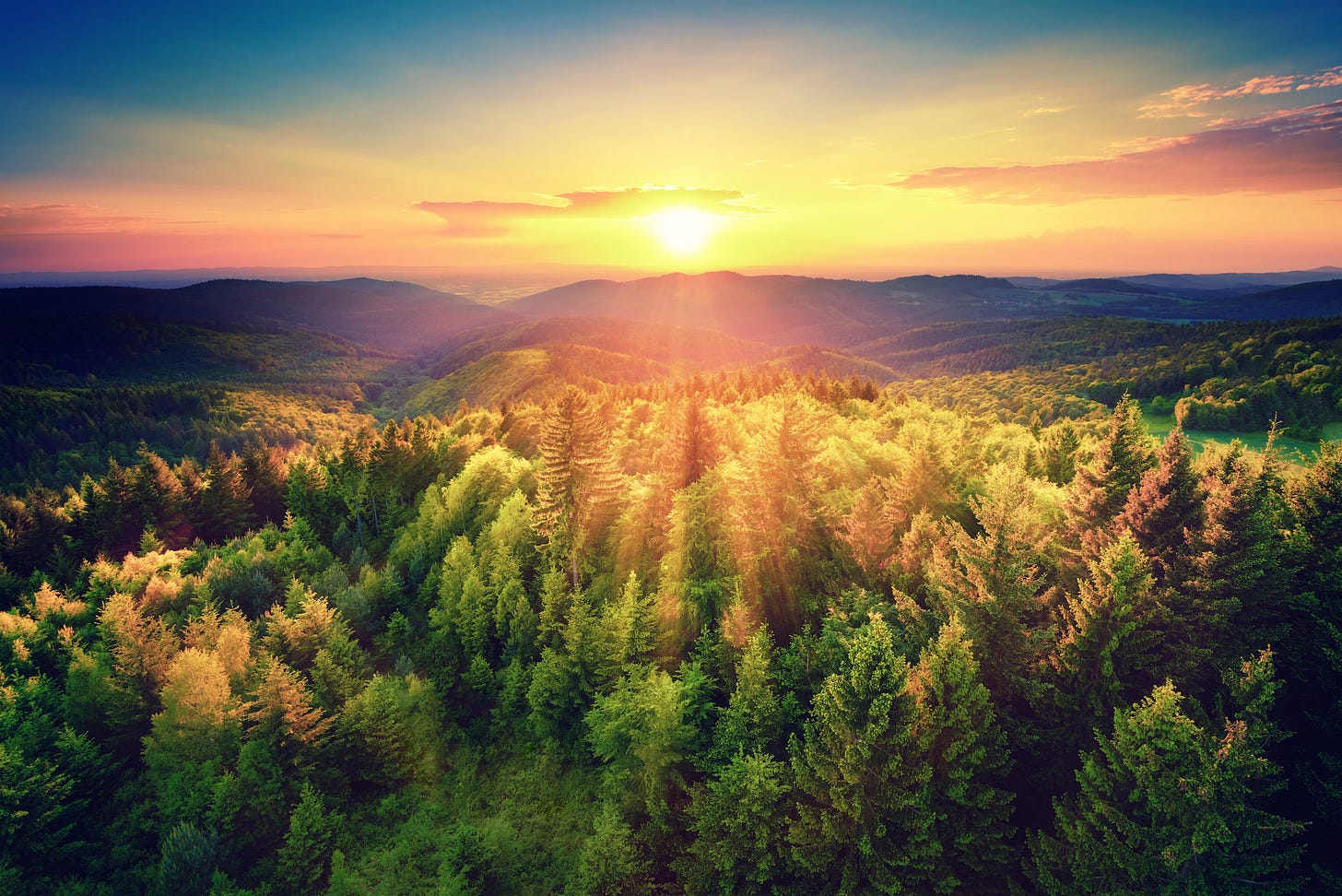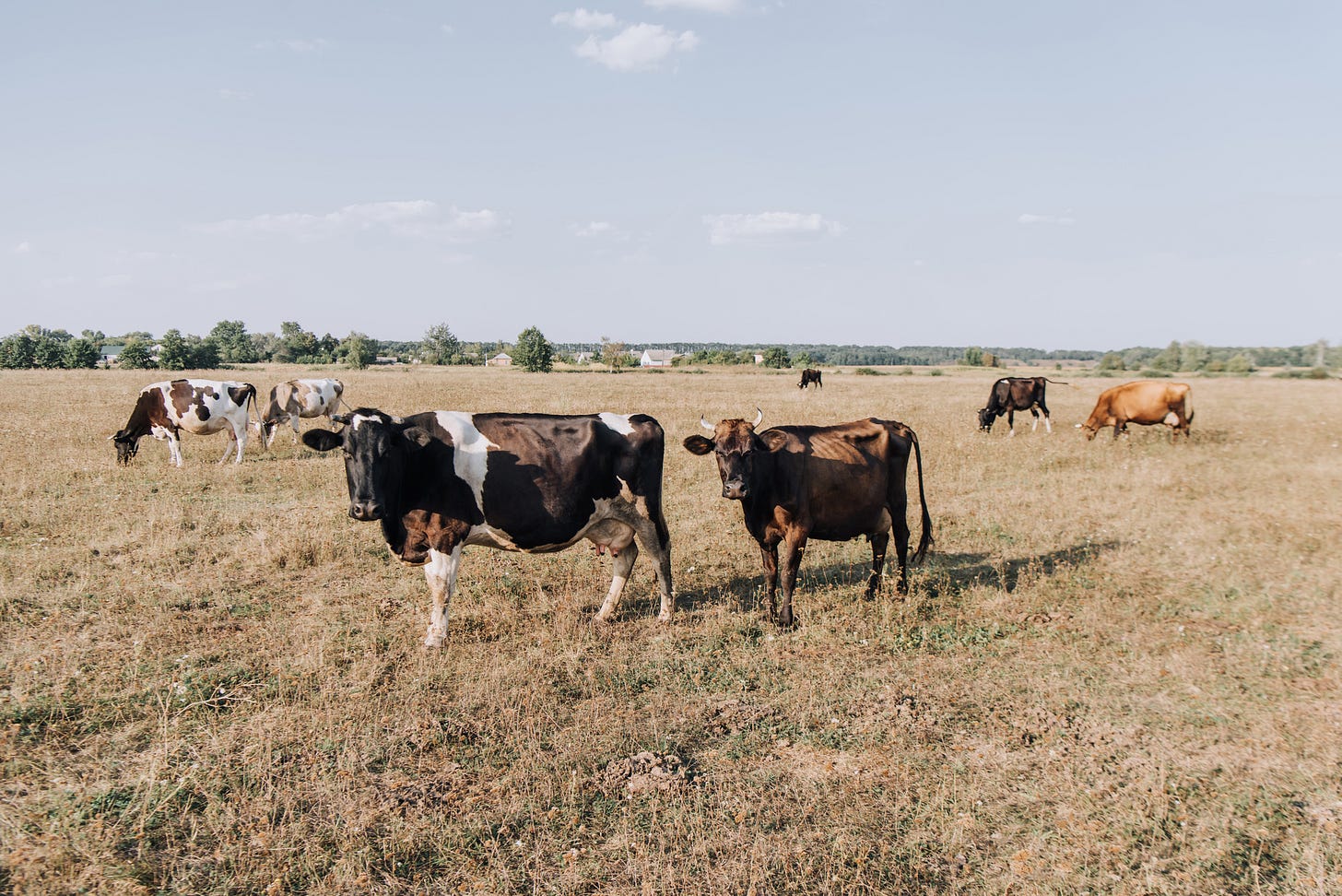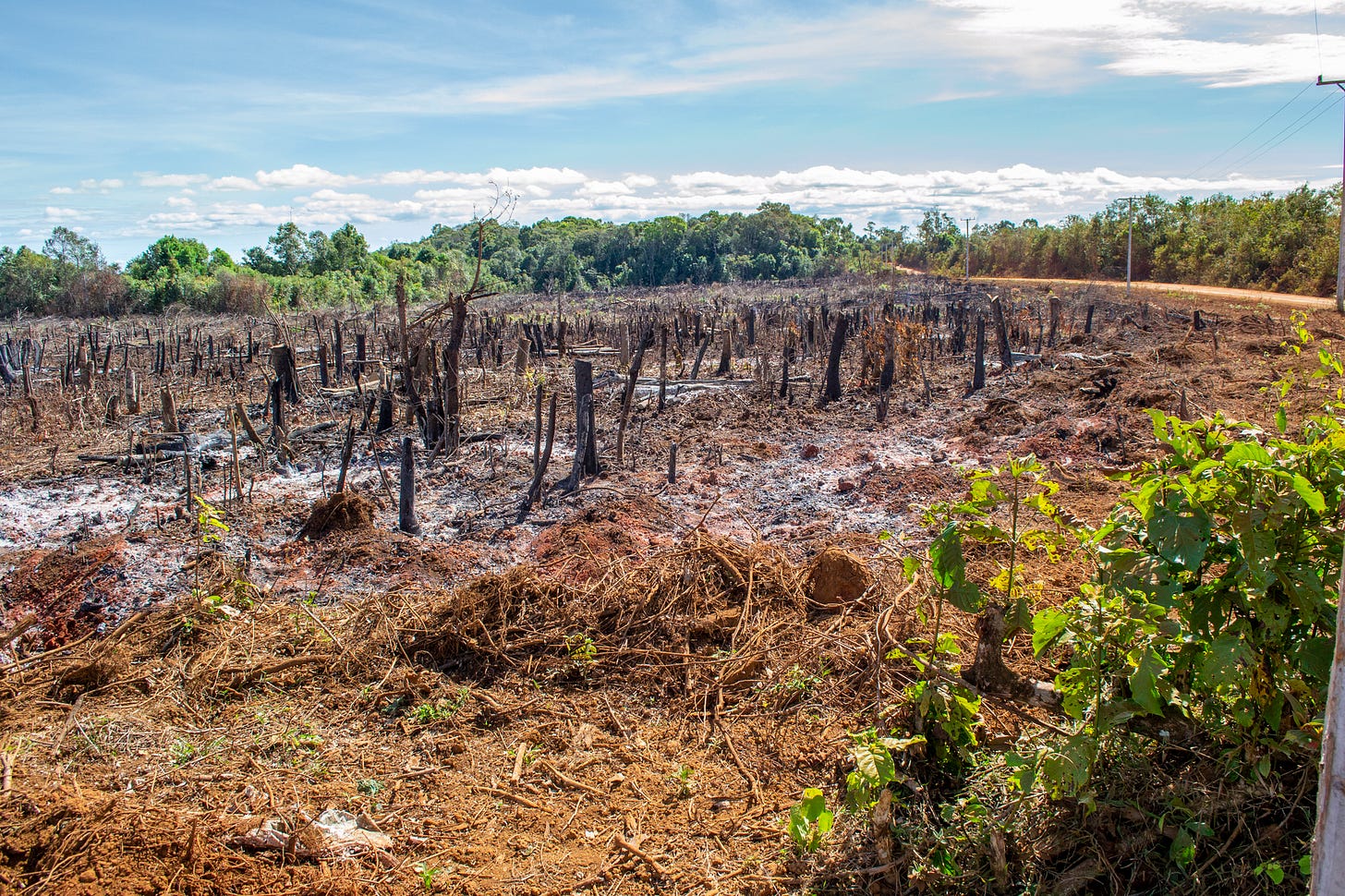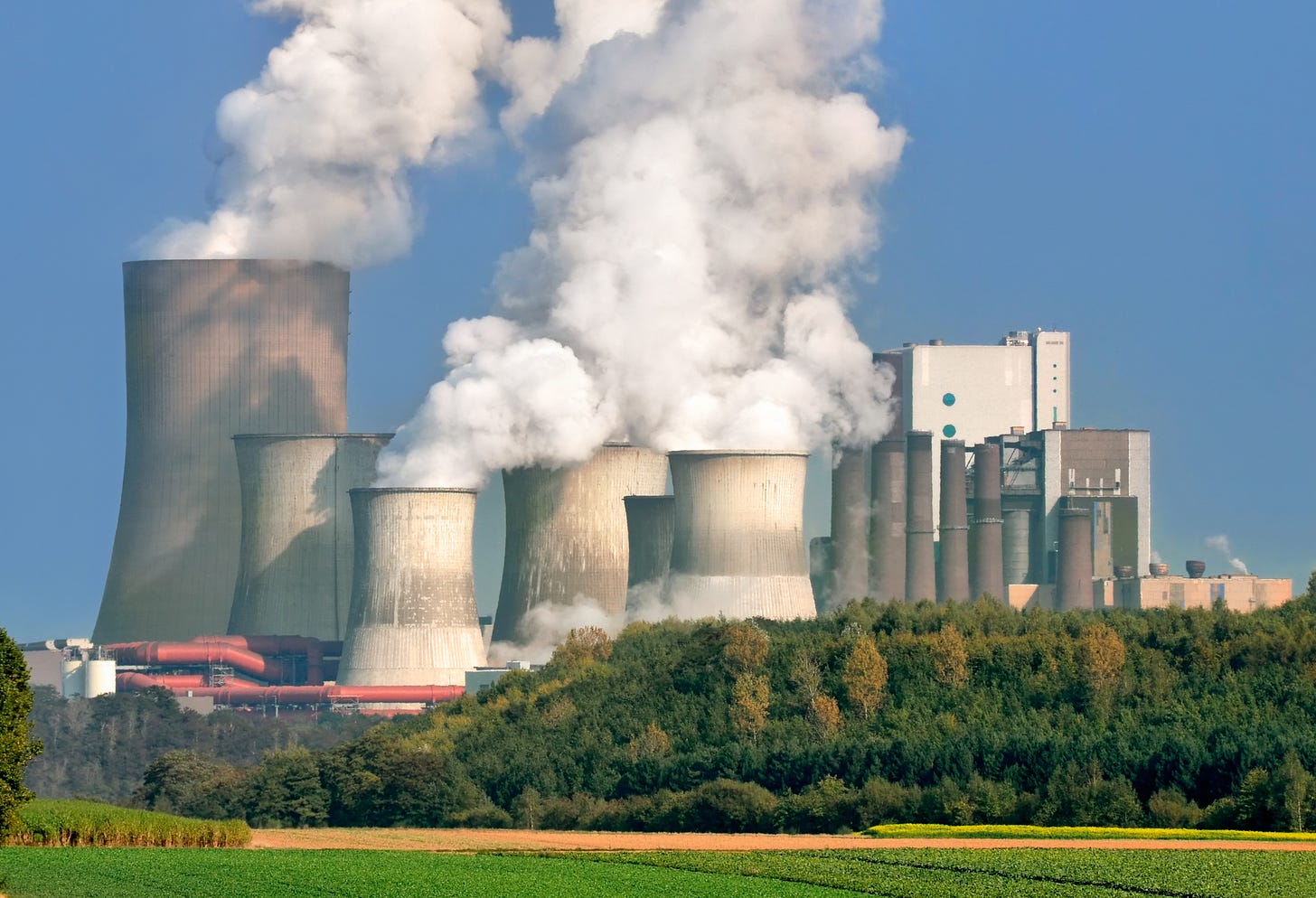Planting Trees Is a Great Plan B
Considerable Potential If We Do It Right, But Halting Emissions And Protecting Existing Forest Come First
Forestation – planting trees – is a much-touted ingredient in the recipe for halting climate change. How much can we rely on it to reduce greenhouse gases?
Of course, the idea of forestation is appealing. “I think that I shall never see / A poem lovely as a tree.” Trees are natural, nice to look at, and provide many benefits beyond absorbing carbon dioxide. But precisely because forestation is so appealing, it’s easy to become over-optimistic about its potential to mitigate climate change.
Last time, in Can't see the Forest For the Tree Plantations, I explored the many factors that affect the climate impact of tree-planting projects. In this post, I’ll dig into how much of the climate problem we can solve this way. Briefly: we could pull down a lot of carbon by planting trees, and the potential side benefits are enormous. But to fully realize this potential would take more land than we’re likely to commit, and would require using it in ways we’re not on track for – fewer plantations, more natural forest. Done improperly, forestation can cause more harm than good.
The primary focus of climate change mitigation must always be to eliminate emissions: replace furnaces with heat pumps, coal plants with wind farms, and so forth. When it comes to trees, reforestation is great but protecting our existing forests (”conservation” or “proforestation”) is more urgent. Climate change calls for an all-of-the-above approach, so we should be pushing to plant more trees, but only alongside emissions reduction and forest preservation.
Come For The CO₂ Sequestration, Stay for the Biodiversity

Before we dive into the CO₂ numbers, remember that forestation has many effects beyond pulling carbon out of the atmosphere. We’re talking about redecorating a significant portion of the planet, so we should expect a few side effects.
It’s important that projects be handled wisely. Ideally, the goal should be to recreate a natural forest, using a mix of species native to the region and appropriate to the terrain, and in consultation with the people in the affected area. Otherwise, a variety of negative effects can occur, and the project is less likely to achieve its basic carbon goals: a poorly-placed forest may destroy important habitat or release soil carbon, an inappropriate forest may not thrive, and an unwanted forest is liable to be cut down.
The benefits can be profound: “soil erosion prevention, recreation, local evaporative cooling, and possibly increased precipitation”1; “water filtration, flood buffering, soil health, biodiversity habitat, and enhanced climate resilience”2. Forests affect the local water cycle, in some cases promoting increased rainfall which can in turn support the health of the forest. Thus, forest restoration creates a positive feedback loop (making it easier for forests to thrive), while deforestation can lead to “desertification”: a negative feedback loop where rainfall decreases, making it harder for the remaining patches of forest to survive.
The downsides primarily occur when attempting to impose a forest on land not well suited to it, or when using inappropriate species, especially monoculture tree plantations. Impacts can include displacement of native species and loss of biodiversity, increase in invasive species, and loss of pollinating insects3, among others. Tree-planting projects may also displace other uses of the land, leading to forests being cleared elsewhere: if you plant trees on land that’s used for cattle grazing, the rancher is liable to raze the next forest over.
In Principle, We Really Could Plant a Lot of Trees
(If you’re not interested in a detailed analysis, feel free to skip to the last paragraph of this section. This entire post is fairly technical; if that doesn’t sound fun, skip directly to the last section to see my conclusions.)
Here are a few sources that model a “maximum” scenario, where we use every acre of land that is suitable for tree cover and is not currently farmed. This is not a realistic prospect, but it puts the potential of forestation into perspective.
I’ll do my best to translate each study into the same units: billions of tons of CO₂ removed per year (Gt CO₂/y)4. We can directly compare these numbers against emissions sources; for instance, passenger cars emit about 3 Gt CO₂/y.
Some models adjust for albedo effects: forests are dark, and so absorb the sun’s heat, thus warming the planet. If a reforestation project takes in 100,000 tons of CO₂ per year, but absorbs enough sunlight to warm the planet as much as 30,000 tons of CO₂ per year would cause, then we say the adjusted effect is to remove 70,000 tons per year. I’ll indicate which models adjusted for this, and which did not. It’s mostly an issue in northern regions that are otherwise covered in (shiny!) snow.
For each model, I’ll report the amount of land proposed for tree planting, in millions of hectares (Mha)5.
Limited climate change mitigation potential through forestation of the vast dryland regions (Science, 2022) projects removal of 5.21 Gt CO₂/y, adjusted for albedo, using 1804 Mha of land. On careful review, this is only for “drylands” (see previous discussion). Adding in tropical rainforest and other non-”dryland” regions would yield higher figures.
The Global Tree Restoration Potential (Science, 2019) projects 205 billion tons of carbon in total, using 1700 to 1800 Mha. I interpreted this as taking place over 80 years (a reasonable time for forest to reach maturity), so 9.39 Gt CO₂/y, not adjusted for albedo effects.
Mapping carbon accumulation potential from global natural forest regrowth (Nature, 2020) presents two figures – a “national commitments” scenario based on what countries have promised to do, and a “maximum” scenario which attempts to model the maximum reasonable amount of land use6. For the maximum scenario, they project 8.91 Gt CO₂/y over the next 30 years, using 678 Mha. This figure is for “natural forest regrowth” (which they define to mean something similar to reforestation), and does not include albedo effects, but they exclude the “boreal” (northern) regions where albedo effects are most pronounced.
So, we have two estimates for annual CO₂ drawdown based on aggressive forestation: 9.39 Gt not allowing for albedo effects, and 8.91 Gt sort-of allowing for albedo effects (but only including reforestation, not “afforestation” on land that was not historically forested). And then we have 5.21 Gt just for “drylands”, and allowing for albedo effects. Worldwide annual greenhouse gas emissions are the equivalent7 of around 50 Gt of CO₂, so removing 5 to 9 Gt would make quite a difference – roughly equivalent to all of the emissions from steel and cement manufacturing, aviation, and shipping8!
Cattle Ranchers Would Like a Word
It’s unrealistic to expect that we’ll actually plant – and maintain! – trees on every possible acre. Determining what we can expect comes down to two questions: what would all of this cost, and what are the competing uses for the land?
I had a hard time understanding the nature of the land under discussion. It’s all suitable for growing trees, but not currently in use for agriculture. What sort of land is that, where is it located, what does it look like, how is it used today? Mapping carbon accumulation potential from global natural forest regrowth notes that the maximum scenario “would require dietary shifts towards a plant-based diet, which could release large areas of current grazing lands back to forest, as well as croplands that are used to produce fodder for livestock”. So it sounds like much of the proposed land is currently used for grazing.
Here are some attempts to model more achievable scenarios, as opposed to the maximum scenarios reviewed above. (Feel free to skip this bullet list.)
Mapping carbon accumulation potential gives 5.86 Gt CO₂/y, using 349 Mha of land, for their “national commitments” scenario9.
Regenerate natural forests to store carbon (Nature, 2019), presents figures based on the Bonn Challenge10: working out to about about 1.91 Gt CO₂/y through 2100, using 350 Mha. I don’t think this accounts for albedo effects, but they do seem to exclude the northern regions where that would make a big difference. They also note that an (older) IPCC report models the potential of reforestation and afforestation at about 2 Gt CO₂/y through the end of the century11.
Natural climate solutions (Proceedings of the National Academy of Sciences, 2017) states that if we limit ourselves to projects that cost less than $100 per ton of CO₂ removed, forestry can draw down 7.3 Gt CO₂/y. If we restrict to $10 / ton, this drops to 2.3 Gt CO₂/y. This is helpful, because it gives us some idea of how much all this might cost. (For perspective, industrial methods for removing CO₂ from the atmosphere are anticipated to cost something like $100 / ton.) These figures are not adjusted for albedo effects, but do exclude areas where the albedo effects would be larger than the CO₂ benefit. I’m not sure how much land would be used in these scenarios; the article mentions figures ranging from 345 to 1,779 Mha.
Negative emissions—Part 2: Costs, potentials and side effects (Environmental Research Letters, 2018) states that “based on a systematic review of the literature, our best estimates for sustainable global NET potentials in 2050 are 0.5–3.6 Gt CO₂/y for afforestation and reforestation”, and mentions a wide range of land areas used, as high as 2580 Mha. They also note that “There is high agreement on the maximal costs” of afforestation and reforestation being around $100 per ton of CO₂.
Project Drawdown projects that 3.2 to 4.96 Gt CO₂/y could be sequestered through 2050 using a combination of tropical forest restoration, temperate forest restoration, and tree plantations on degraded land, using a total of 366 – 533 Mha.
This is a wide range of figures, from 0.5 to 7.3 Gt CO₂/y. However, progress to date suggests that we might fall far short of even these “achievable” scenarios:
Mapping carbon accumulation potential notes that this scenario “will be difficult to achieve, with some countries committing to the restoration of more forest area than is available and relying on approaches other than natural forest regrowth to restore forests.”
Regenerate natural forests to store carbon notes that their figures would require all 350 Mha to be allowed to become natural forest; under “current plans”, which include plantations and other less-than-natural forms of tree planting, they project only 0.73 Gt CO₂/y.
Regenerate natural forests to store carbon notes that just a third of Bonn Challenge pledges are for land to be returned to natural forest; the remainder is slated for tree plantations and agroforestry (mixing trees with other crops), which may sequester much less CO₂, depending on how the wood is used. Also, if such a large increase in commercial tree plantings actually came to pass, that would presumably depress the price of wood products, calling into question whether these plans would actually be sustained.
The global tree restoration potential notes that 10% of countries in the Bonn Challenge “have committed to restoring an area of land that considerably exceeds the total area that is available for restoration”, another sign that these commitments may not be well thought out.
Might we do better? In climate action, the pattern has been for national plans and commitments to start out highly inadequate, but improve over time. Plans for deploying clean power, electrifying transportation, and so forth keep accelerating. Perhaps we can hope for forestation plans to similarly increase. However, I’m not terribly optimistic about this. In many areas, climate change mitigation benefits from both increased awareness of the urgency of the problem, and the falling cost of clean technologies. When it comes to forestation, the latter doesn’t seem to apply; there’s no technological advance that brings down the cost of “please stop grazing your cattle here” the way we’ve brought down the cost of solar panels and EV batteries. It’s gotten to the point where the profit motive often pushes utilities to shut down coal plants, but there’s not much profit motive for natural forest restoration12. So it’ll be a tougher climb.
Perhaps most telling is the fact that deforestation continues unabated in many parts of the world. How feasible are global forest restoration commitments?13 examines this, noting that “tropical forests are being lost at a rate of 15.8 million hectares a year”, a high rate. If we haven’t even managed to stop cutting forests down, how do we expect to undertake the difficult work of restoring them? The same source also notes that many “restoration” commitments may not reflect true reforestation; for instance, “… although the United States officially reported restoring nearly 17 million hectares, only 4% … consisted of newly planted forests, agroforestry, or natural regeneration, with the remainder in silvicultural treatments like thinning and prescribed burning that restore existing forests.”
Forestation: Part Of a Balanced Diet
At the end of the day, what can we realistically hope to accomplish by planting trees? I think we can take the Project Drawdown range of 3.2 to 4.96 Gt CO₂/y as an optimistic upper bound; the reality is likely to be less. Those figures would require devoting 366 to 533 Mha of land. For comparison, I estimated an upper bound of 122 Mha of new land needed for renewable energy in 2050, and Wikipedia says that 4,911 Mha is used for agriculture. So a serious forestation effort will use much more land than renewable energy, but much less than agriculture.
Clearly, trees alone can’t counterbalance worldwide emissions, which are around 50 Gt of CO₂e/y. Over the centuries, we’ve cut down forests and burned vast quantities of fossil fuel. Reversing deforestation alone won’t undo fossil fuel emissions. And the agricultural needs of 8 billion people mean that complete reforestation is not in the cards.
We must find ways to eliminate almost all of the things we do that emit greenhouse gases – including the ongoing destruction of natural forests. We should only look for counterbalances to those few emissions sources that we can’t eliminate; this is where forestation can play a role. We need to find ways to promote “good” forestation, without excessive reliance on plantations and other projects that are potentially harmful, or at least not as helpful as natural forest. Even one or two gigatons per year would be a huge contribution, so forestry is a critically important piece of the climate puzzle. It’s just not a silver bullet – nothing ever is.
Many sources specify the amount of carbon removed, rather than the amount of CO₂. To convert carbon to CO₂, we multiply by 3.6667 – the ratio of the weight of a CO₂ molecule to a carbon atom.
The time frame also varies; typically, the figures are an average over either the period 2020-2050 or 2020-2100. The actual rate of carbon drawdown would vary significantly across that period, which has important implications – as much as possible, we need to reduce greenhouse gases soon to minimize climate impacts and avoid tipping points – but it’s too much for me to explore here. In any case, the carbon drawdown of new forests would start to saturate in the second half of the century, so by then we’ll need to move on to other methods for reducing greenhouse gases.
A hectare is about 2.5 acres, and 1 Mha is 3861 square miles.
From the Nature article: “…estimate of maximum biophysical area (678 Mha) that excludes grassland biomes to avoid negative biodiversity consequences, the boreal biome owing to potentially adverse warming effects from changes in albedo, current croplands to safeguard human needs for food, and rural and urban population centres”.
This figure converts methane, N₂O, and other greenhouse gases into an amount of CO₂ that would cause a roughly equivalent amount of warming.
Per https://ourworldindata.org/emissions-by-sector, these respectively constitute 7.2%, 3%, 1.9%, and 1.7% of greenhouse gas emissions, for a total of 13.8%. That’s against total emissions of 49.4 Gt of CO₂ (or equivalent), so about 6.8 Gt – well within the 5-to-9 Gt range for aggressive forestation.
Based on the Paris Agreement, and commitments countries have made under the Bonn Challenge.
Here’s a good description of the Bonn Challenge (from Nature):
…in 2011, the German government and the International Union for Conservation of Nature launched the Bonn Challenge (www.bonnchallenge.org), which aims to restore 350 Mha of forest by 2030. Under this initiative and others, 43 countries across the tropics and subtropics where trees grow quickly, including Brazil, India and China, have committed nearly 300 Mha of degraded land.
That source also notes that an (older) IPCC report models the potential of reforestation and afforestation at about 2 Gt CO₂ / year through the end of the century.
Except via carbon offset markets, which have their own challenges.
Conservation Letters, 2020





Excellent article 💚!!